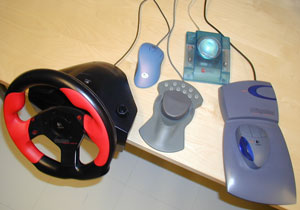


Image from Univesity of Tampere
A touch-enabled device transfers forces to a user's hand or fingers under the direction of a computer. The ability of the TouchSense device to play tactile effects depends on special hardware inside the device, in combination with software which directs what kinds of effects the device should play--not just any peripheral device will do.
Joysticks, steering wheels, and gamepads used in computer games comprise one class of touch device: game controllers. As a gamer turns a simulated airplane or race car with a joystick or steering wheel, he or she feels a physical sensation--which may take the form of an increase in pressure or vibration--which is how a real flight stick or steering wheel feels under the same circumstances. Games were and are an important proving ground for touch-enabled devices and user interfaces.
Immersion designed several types of touch-enabled computer mice that extend the sense of touch to mainstream PC users. These users may now engage a third sense while they surf the web, use productivity applications, and perform other tasks on their computer's desktop. Immersion's TouchSense mice fall into a second class of touch device known as pointing devices.
Touch-enabled devices vary not only in form, but also in the range and quality of sensations they deliver. The simplest devices have very limited repertoires: they pulse and vibrate without control over the properties of the vibration. The most complex devices exert rapidly changing forces on all of their axes. Most devices fall somewhere between the simplest and the most complex, providing the ability to move in one or two axes and independently modulate several properties of the forces they exert. Remember that simple touch sensations, such as vibration, are not without value; game users, for example, are adept at "suspending disbelief" and interpreting vibrations meaningfully, especially when they are reinforced by visual or sound effects.
For general use, a wider range of available sensations gives user interface designers the ability to create more realistic experiences for their users. With the right combinations of forces, a mouse or joystick reacts like an elastic material, or feels as though it is moving through liquid or across a textured surface. Compelling sensations are rich in complexity, achieved by adjusting forces on all axes simultaneously and rapidly. Designing such a device is a challenging engineering effort, especially when minimizing size and cost. The increased versatility gives user interface designers a broader palette from which to compose touch sensations that best convey an experience. As an analogy, consider black-and-white graphics versus color. Consider 256 colors versus 16 million.
<<
Back to your previous page
Immersion Support Index